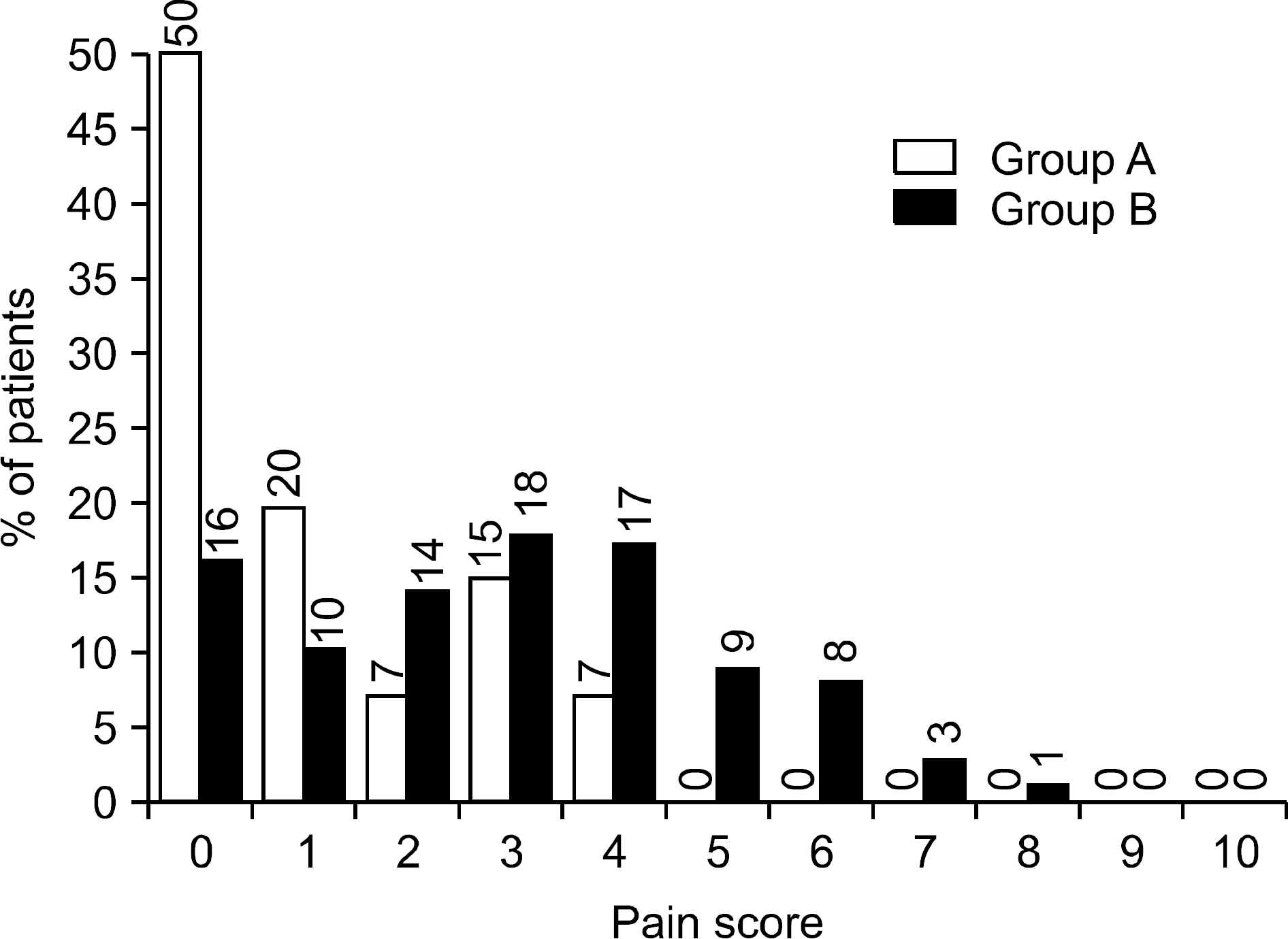Abstract
Purpose
Transrectal ultrasonography (TRUS)-guided prostate biopsy causes fear and pain in 65% to 90% of patients. This study was designed to evaluated the use of intravenous propofol anesthesia during TRUS-guided prostate biopsy.
Materials and Methods
Between January 2006 and June 2008, 195 men undergoing a transrectal prostate biopsy were divided into 2 groups according to anesthetic technique. Group A consisted of 99 patients who received intravenous propofol infusion through an 18 gauge needle during TRUS-guided prostate biopsy. Group B consisted of 96 patients who intrarectally received 10 ml of 2% lidocaine gel 10 minutes before TRUS-guided prostate biopsy. Pain scores were assessed on a visual analogue scale immediately after prostate biopsy.
Results
The pain score was significantly reduced in group A compared with group B. There was a significant difference in the mean pain score between the 2 groups (1.0±1.3 in group A versus 2.9±2.0 in group B; p< 0.01). Also, there was a significant difference in the willingness to undergo rebiopsy between the 2 groups (83.8% in group A versus 17.7% in group B; p<0.01). However, the complication rates were not significantly different between the 2 groups. Gross hematuria was found in 14% of group A patients and 18% of group B patients.
REFERENCES
1. Greenlee RT, Murray T, Bolden S, Wingo PA. Cancer statistics, 2000. CA Cancer J Clin. 2000; 50:7–33.

2. Collins GN, Lloyd SN, Hehir M, McKelvie GB. Multiple transrectal ultrasound-guided prostatic biopsies–true morbidity and patient acceptance. Br J Urol. 1993; 71:460–3.

3. Aus G, Hermansson CG, Hugosson J, Pedersen KV. Transrectal ultrasound examination of the prostate: complications and acceptance by patients. Br J Urol. 1993; 71:457–9.

4. Nash PA, Bruce JE, Indudhara R, Shinohara K. Transrectal ultrasound guided prostatic nerve blockade eases systematic needle biopsy of the prostate. J Urol. 1996; 155:607–9.

5. Irani J, Fournier F, Bon D, Gremmo E, Dore B, Aubert J. Patient tolerance of transrectal ultrasound-guided biopsy of the prostate. Br J Urol. 1997; 79:608–10.

6. 2002’ Annual reports of Central Cancer Registry Center in Korea. National Cancer Center of Korea.
7. Soloway MS, Obek C. Periprostatic local anesthesia before ultrasound guided prostate biopsy. J Urol. 2000; 163:172–3.

8. Borboroglu PG, Comer SW, Riffenburgh RH, Amling CL. Extensive repeat transrectal ultrasound guided prostate biopsy in patients with previous benign sextant biopsies. J Urol. 2000; 163:158–62.

9. Aus G, Damber JE, Hugosson J. Prostate biopsy and anaesthesia: an overview. Scand J Urol Nephrol. 2005; 39:124–9.

10. Patterson KW, Casey PB, Murray JP, O'Boyle CA, Cunningham AJ. Propofol sedation for outpatient upper gastrointestinal endoscopy: comparison with midazolam. Br J Anaesth. 1991; 67:108–11.

11. Chanvej L, Kijsirikul S, Thongsuksai P, Naheem L. Postoperative nausea and vomiting in outpatient gynecologic laparoscopy: a comparison of thiopental-nitrous oxide, propofol-nitrous oxide and total intravenous anesthesia using propofol. J Med Assoc Thai. 2001; 84:697–704.
12. Beller JP, Pottecher T, Lugnier A, Mangin P, Otteni JC. Prolonged sedation with propofol in ICU patients: recovery and blood concentration changes during periodic interruptions in infusion. Br J Anaesth. 1988; 61:583–8.

13. Kitamura T, Fujiwara H, Nagata O, Usui H, Suzuki T, Ogawa M, et al. Anesthetic management using propofol and fentanyl for transrectal ultrasound-guided prostatic biopsy. Masui. 2001; 50:1209–12.
14. Peters JL, Thompson AC, McNicholas TA, Hines JE, Hanbury DC, Boustead GB. Increased patient satisfaction from transrectal ultrasonography and biopsy under sedation. BJU Int. 2001; 87:827–30.

15. Park JY, Park SJ, Choi SU, Shin HW, Lee HW, Lim HJ, et al. Target-controlled propofol infusion for sedation in patients undergoing transrectal ultrasound-guided prostate biopsy. J Int Med Res. 2007; 35:773–80.

16. Kim KS, Kim JS, Park SW. Study on the effects and safety of propofol anesthesia during cystoscopy. Korean J Urol. 2006; 47:1230–5.

17. Lee JW, Jeong JY, Yoo TK. Ureteroscopy under intravenous propofol anesthesia for the treatment of middle and upper ureteral calculi: comparison with lower ureteral calculi. Korean J Urol. 2002; 43:738–42.
18. Issa MM, Bux S, Chun T, Petros JA, Labadia AJ, Anastasia K, et al. A randomized prospective trial of intrarectal lidocaine for pain control during transrectal prostate biopsy: the Emory University experience. J Urol. 2000; 164:397–9.

19. Stirling BN, Shockley KF, Carothers GG, Maatman TJ. Comparison of local anesthesia techniques during transrectal ultrasound-guided biopsies. Urology. 2002; 60:89–92.

Fig. 1.
Individual pain assessment by category. Group A: intravenous propofol, Group B: intrarectal lidocaine gel.

Table 1.
Characteristics of the patients
| Group A | Group B | p-value | |
|---|---|---|---|
| No. of patients | 99 | 96 | |
| Age (years) | 67.3±9.1 | 67.8±10.4 | 0.855 |
| PSA (ng/ml) | 14.0±23.2 | 13.9±21.6 | 0.979 |
| Prostate volume (ml) | 62.7±23.1 | 63.1±27.2 | 0.910 |
Table 2.
Comparison of results between groups and willingness to undergo prostate rebiopsy




 PDF
PDF ePub
ePub Citation
Citation Print
Print


 XML Download
XML Download